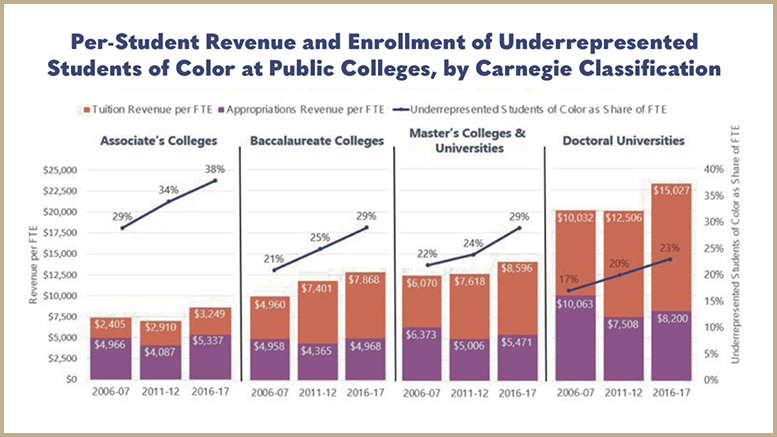Since the recession, states have bolstered funding for community colleges at higher levels than for other public postsecondary institutions, but they still receive less in total per-student revenue than those other colleges and universities, according to a new report.
That’s important when it comes to providing academic and non-academic supports to help underrepresented students of color — many of whom attend community colleges — succeed in college and improve their economic mobility, says the report from the Institute for College Access & Success (TICAS).
“Our public universities and community colleges should be some of the country’s most important institutions for equal opportunity, but they aren’t working that way,” TICAS President James Kwaal said in a press release. “Black, Latino and other students of color are most likely to attend underfunded colleges where they are less likely to graduate.”
Climbing back up
During the recession, states and local governments cut funds for higher education, with community colleges seeing an 18 percent decrease and baccalaureate colleges a 12 percent cut, the report says. Master’s-degree universities saw a 21 percent cut and doctoral universities a 25 percent drop. Community colleges were the sole public college sector to see a decline in total per-student revenue between 2006 and 2011, the report noted.
At the same time, the percentage of underrepresented students of color at community colleges continued to grow. Their full-time enrollment at associate-degree colleges increased from 29 percent in 2006-07, to 34 percent in 2011-12, and up to 38 percent in 2016-17. At baccalaureate colleges, their shares increased from 21 percent, to 25 percent, to 29 percent, respectively.
To make up for lost appropriations, public colleges raised tuition. Between 2006 and 2016, tuition revenue increased by $850 per student at community colleges, and $5,000 per student at doctoral universities, the report says. Even with recent state funding increases, tuition still comprises a higher share of total revenue for all public colleges than before the recession, TICAS notes, though community colleges continue to rely less on tuition revenue than other public colleges and universities.
After the recession, states began to reinvest in higher education. Between 2011 and 2016, per-student state and local appropriations for community colleges grew by 31 percent, with baccalaureate colleges seeing a 14 percent increase, and both master’s and doctoral universities seeing a 9 percent increase. Community colleges were the only public higher education sector that saw a net increase in per-student state and local funding from 2006 to 2016, the report says.
Gap still there
Despite the public reinvestment in community colleges, there’s still a sizeable gap regarding total per-student support for their students compared to other public colleges, the report notes. It adds that community colleges — like many other less-selective, non-research-intensive, public four-year colleges — don’t have revenue sources beyond public funding and tuition, such as endowments, research and affiliated medical facilities, that research-heavy universities have.
TICAS also examined patterns of resource disparities in California, Illinois, New York, North Carolina and Texas, which together enroll more than one-third of public college students. In all those states, community colleges receive no more than half — and as little as 22 percent — of per-student revenue received by doctoral universities.

